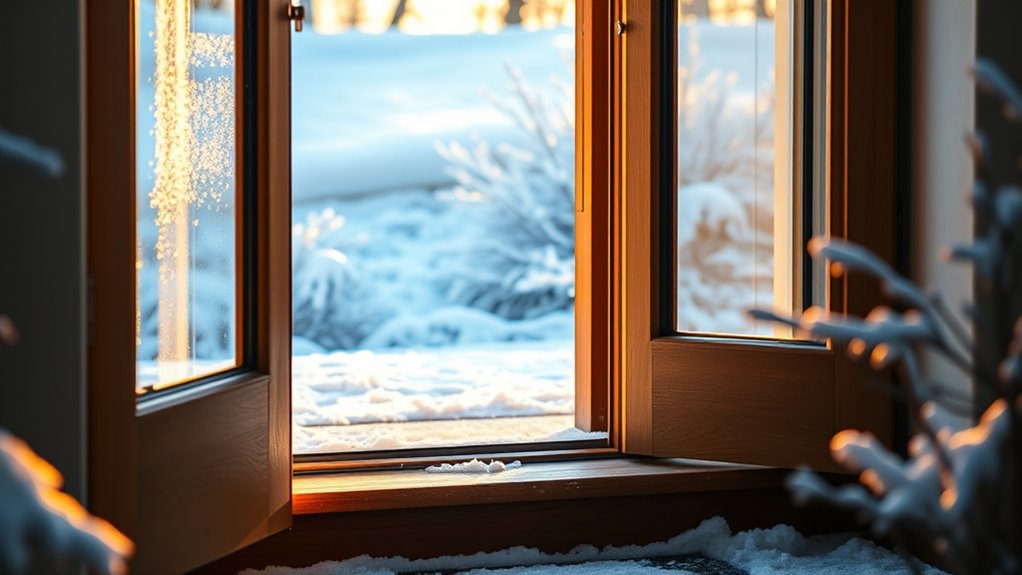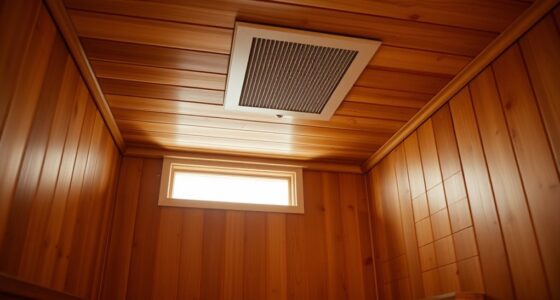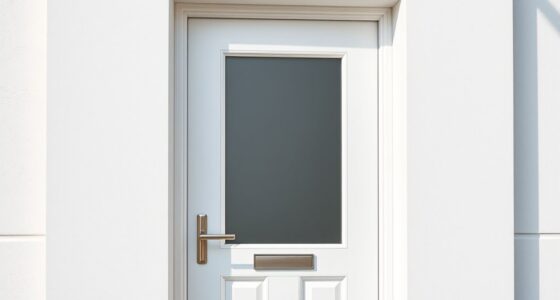Improper door placement can silently cause higher energy bills, increased drafts, and structural issues, leading to hidden costs. Heat loss calculators help you identify weak spots and optimize your door positioning, but neglecting these tools can mean missed savings and ongoing inefficiencies. By understanding key factors like insulation, gaps, and placement, you can avoid costly mistakes. Keep exploring; you’ll discover practical tips to guarantee your doors save energy and money in the long run.
Key Takeaways
- Poor door placement increases heat transfer, leading to higher energy bills and potential structural damage over time.
- Heat loss calculators help identify weak points in insulation, preventing costly inefficiencies and energy waste.
- Gaps, misaligned frames, and unsuitable materials in door installation cause drafts and hidden heat loss costs.
- Ignoring proper door positioning can accelerate wear and tear, resulting in expensive repairs and reduced door lifespan.
- Regular assessment and strategic placement using heat loss tools can significantly reduce long-term hidden costs.
How Door Placement Affects Thermal Performance
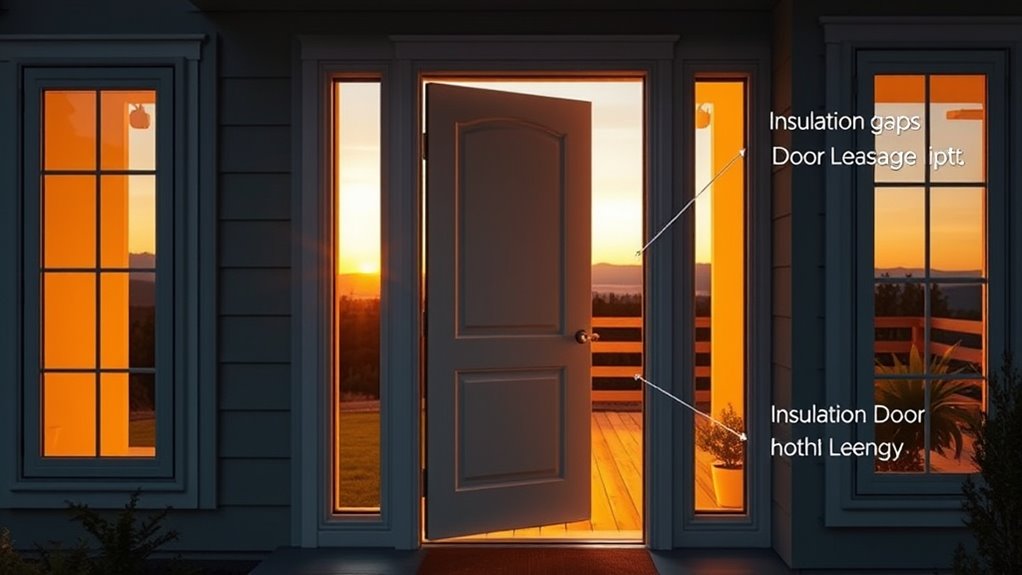
The placement of a door considerably impacts your home’s thermal performance by influencing heat transfer and energy efficiency. Door orientation plays a critical role—placing doors to minimize exposure to harsh sunlight or prevailing winds helps reduce heat loss or gain. Proper orientation can prevent thermal bridging, where heat bypasses insulation through poorly placed door frames or gaps. If your door faces cold exterior walls or unprotected outdoor areas, it increases the chances of heat escaping, forcing your heating system to work harder. Additionally, using energy-efficient doors can significantly enhance insulation and reduce thermal transfer. Conversely, strategic placement—such as positioning doors away from uninsulated walls or draft-prone zones—can markedly cut energy costs. By carefully considering door orientation and addressing potential thermal bridging, you optimize your home’s insulation and keep indoor temperatures stable.
Common Mistakes in Door Location Planning
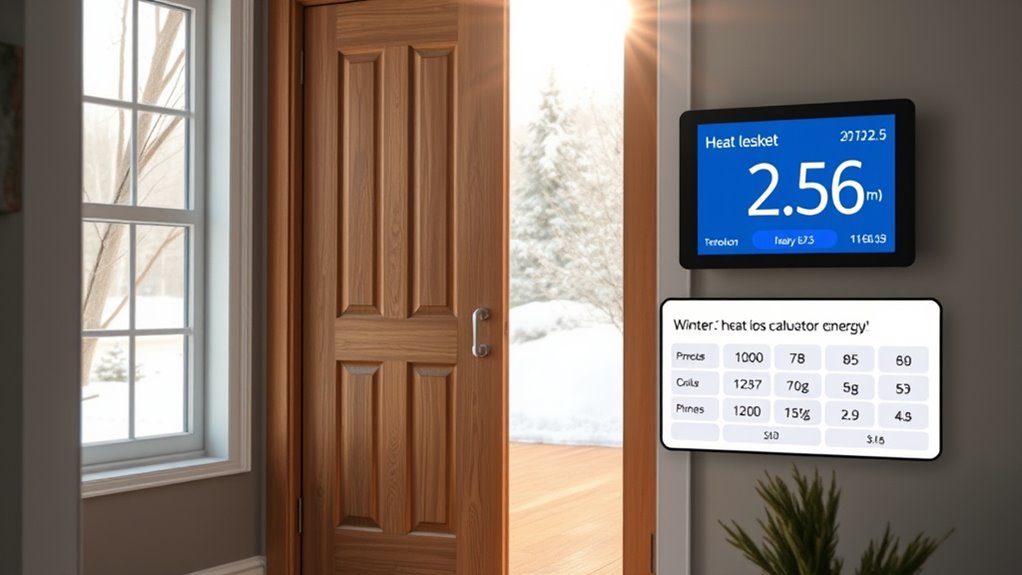
Many homeowners overlook key factors when planning door placement, leading to increased heat loss and higher energy bills. A common mistake is placing doors without considering door insulation, which can markedly impact thermal efficiency. Poorly insulated doors allow more heat to escape, forcing your heating system to work harder. Additionally, overlooking wind infiltration around door frames exacerbates energy loss. Gaps and improper sealing create drafts that make your home colder and increase heating costs. Another mistake is positioning doors where they’re exposed to prevalent wind directions, allowing cold air to enter easily. To avoid these issues, focus on proper door insulation and sealing, and carefully select door locations that minimize exposure to wind infiltration. Proper planning helps you save money and maintain a comfortable indoor environment. Furthermore, integrating security measures like sturdy door frames and seals can prevent unauthorized entry while improving energy efficiency.
Understanding Heat Loss and Its Impact on Your Energy Bills
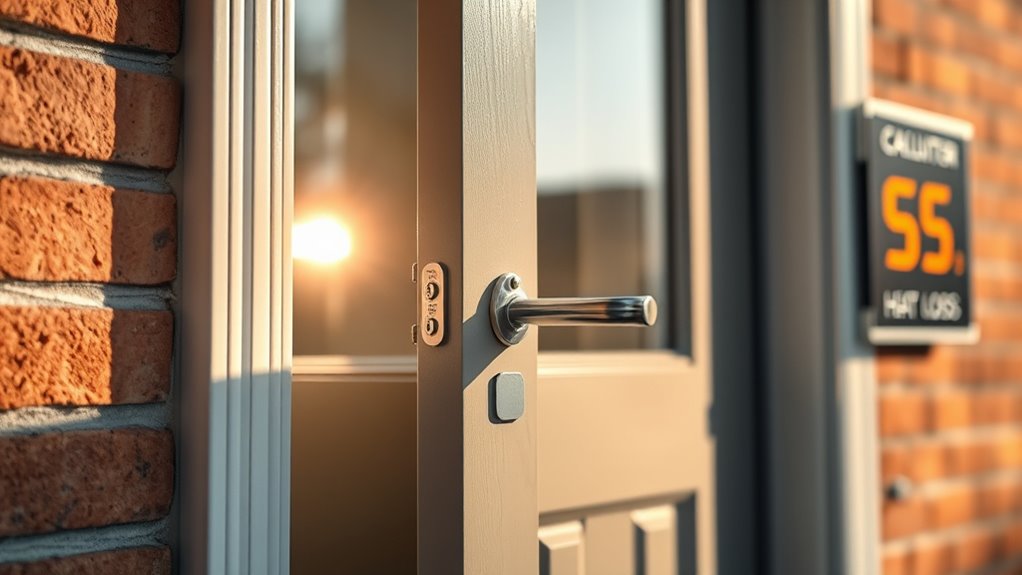
Understanding heat loss is essential because it directly affects how much energy your home consumes. When your home isn’t properly insulated, heat escapes more easily, leading to higher energy bills. Insulation standards set the baseline for keeping your home warm and reducing heat transfer. Conducting regular energy audits helps identify areas where heat loss occurs, highlighting potential upgrades to improve efficiency. Poor door placement can create drafts, increasing heat loss and forcing your heating system to work harder. By understanding how heat escapes and evaluating your home’s insulation, you can make smarter decisions that lower energy costs. Additionally, automation technologies are increasingly used in energy management to optimize heating and cooling systems for better efficiency. Addressing these issues not only saves money but also enhances comfort and reduces your carbon footprint.
The Role of Heat Loss Calculators in Building Design

Heat loss calculators help you get accurate estimates of how heat moves through your building. They enable you to optimize your design for better energy efficiency and comfort. By using these tools, you can save costs and reduce ongoing energy expenses effectively. Additionally, understanding energy-efficient design principles can further enhance your building’s performance.
Accurate Heat Transfer Estimates
Accurate heat transfer estimates are essential for effective building design, as they determine how well a structure retains or loses heat. Heat loss calculators help you predict these estimates by considering factors like window insulation and air sealing. Properly evaluating window insulation ensures that heat isn’t escaping through poorly sealed or inefficient windows, saving you energy costs. Air sealing minimizes air leaks that can substantially increase heat transfer, making your home less energy-efficient. With precise calculations, you can identify weak points in your building’s envelope and address them before construction or renovation. This leads to better comfort, lower energy bills, and reduced environmental impact. Relying on accurate heat transfer estimates enables you to make informed decisions about materials and design elements that optimize thermal performance.
Design Optimization Strategies
Integrating heat loss calculators into your building design allows you to identify and address potential energy inefficiencies early in the process. This proactive approach helps optimize interior aesthetics while reducing heat loss. By analyzing the calculator’s data, you can make strategic decisions on door placement and material choices, balancing functionality and style. Consider these strategies:
- Select door materials with superior insulation properties to minimize heat transfer
- Adjust door placement to reduce exposure to external walls or high-traffic areas
- Incorporate thermal breaks or weatherstripping for better sealing
- Use door design features that complement interior aesthetics without sacrificing efficiency
- Optimize window and door combinations for maximum energy conservation
- Regularly assess and rotate items to prevent clutter buildup, which can also impact insulation and energy efficiency.
Applying these tactics ensures your building is both visually appealing and energy-efficient, thanks to the insights provided by heat loss calculations.
Cost and Energy Savings
By utilizing heat loss calculators during the design process, you can identify opportunities to reduce energy consumption and lower long-term costs. For example, upgrading insulation in walls and roofs minimizes heat transfer, saving you money on heating and cooling. Additionally, selecting effective window treatments, like double-glazed windows or thermal curtains, helps prevent heat loss through windows. These improvements work together with precise calculations to optimize your building’s efficiency. Proper storage of materials and careful maintenance can also prevent issues like mold or damage that may lead to costly repairs later. By addressing heat loss early, you avoid costly retrofits later. The calculator guides you in making informed decisions about where to invest in insulation upgrades or better window treatments, maximizing energy savings. Ultimately, this approach reduces your utility bills and improves comfort, demonstrating how strategic planning pays off over time.
Key Factors Influencing Heat Transfer Through Doors
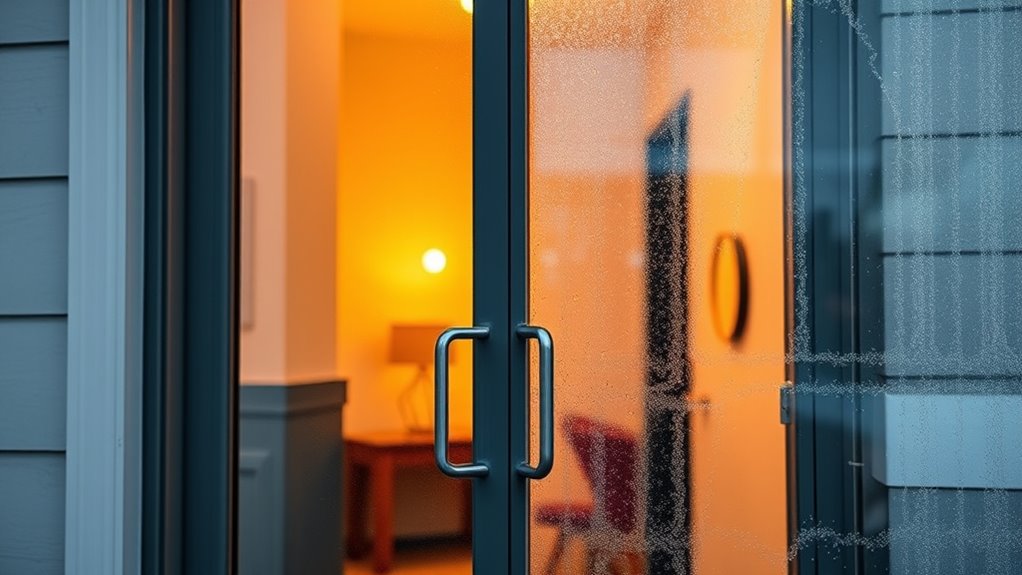
Several key factors influence how much heat passes through a door, affecting your overall energy efficiency. Understanding these factors helps you minimize heat loss and save on energy costs.
- Thermal bridging: Metal frames or poorly connected materials create paths for heat to escape.
- Insulation gaps: Cracks or poorly sealed edges allow drafts and increase heat transfer.
- Door material: Solid wood, steel, or fiberglass have different insulation properties.
- Door installation: Proper fitting prevents air leaks and reduces heat transfer.
- Door design: Windows or glass panels can substantially impact insulation, especially if not double-glazed.
Focusing on reducing thermal bridging and sealing insulation gaps can dramatically improve your door’s thermal performance and overall energy efficiency.
Enhancing door insulation with proper materials can further reduce heat transfer and improve energy savings.
RecognizingSigns of Poor Door Placement in Your Home
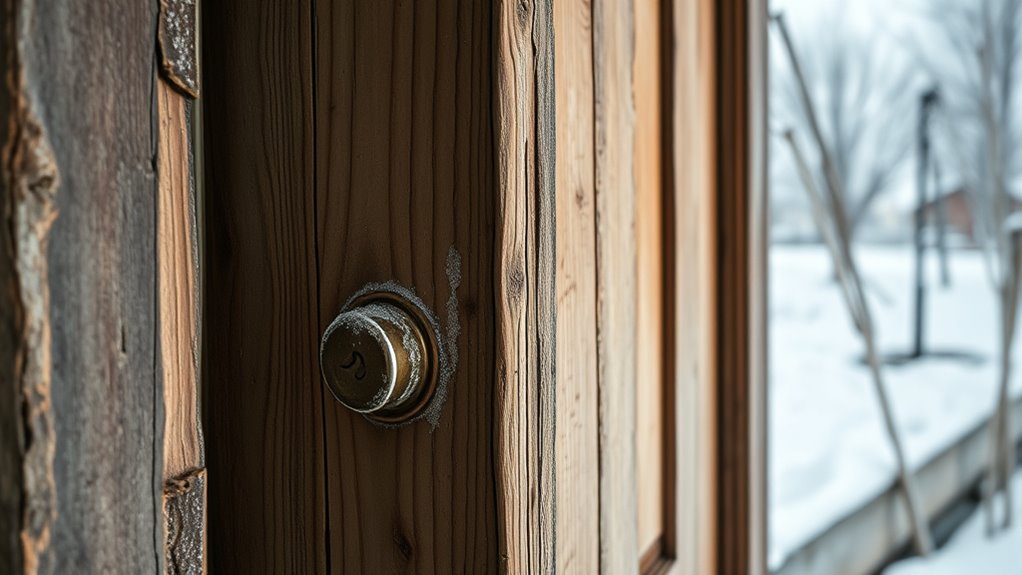
Poor door placement often results in noticeable drafts, uneven heating or cooling, and increased energy bills. Look for drafts around the door frame, especially near the hinges, which can indicate poor alignment or an ill-fitting door. Uneven temperature zones near the door suggest poor placement, causing heat loss or gain. Additionally, frequent door squeaks or difficulty closing may point to misaligned hinges or an improper door frame setup. Using a headphone to listen for sounds indicating air leaks can help identify problem areas.
Practical Steps to Optimize Door Positioning
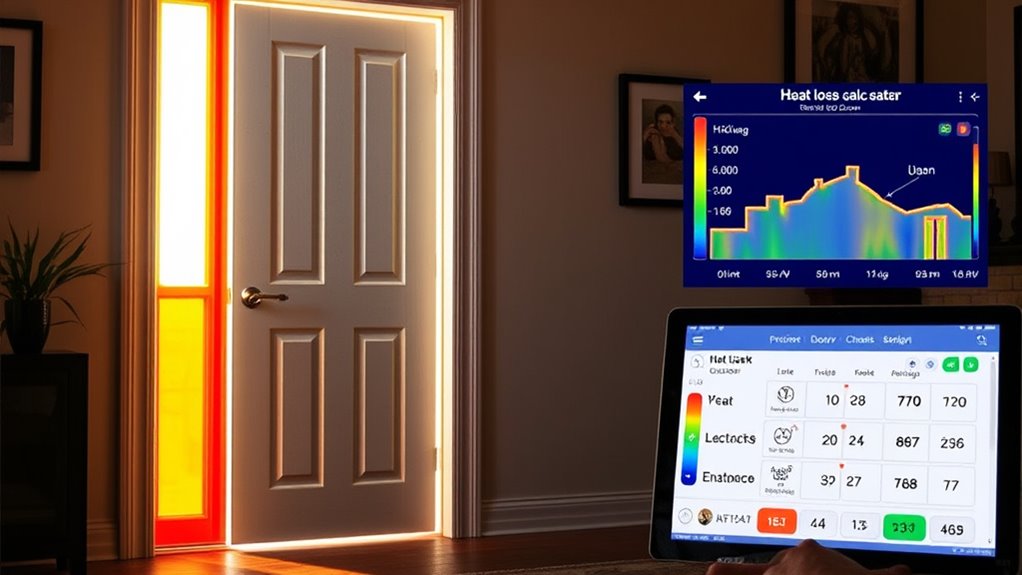
To optimize door positioning effectively, start by inspecting the door and its frame for visible misalignments or gaps. Proper placement enhances door aesthetics and ensures security considerations are met. Next, consider these practical steps:
Start by inspecting for misalignments and gaps to ensure both security and aesthetic appeal.
- Adjust hinges or frame to correct misalignment
- Seal gaps with weatherstripping for better insulation
- Reposition the door to reduce drafts and heat loss
- Ensure the door opens and closes smoothly without obstruction
- Match door placement with interior and exterior design for visual appeal
- Remember that heat loss can be significantly minimized through precise door placement and sealing techniques.
Focusing on precise positioning reduces heat loss and improves security, preventing unauthorized access. Properly aligned doors also boost overall aesthetics, making your home look neater and more inviting. Taking these steps helps you avoid hidden costs associated with inefficient door placement and enhances both function and style.
Tools and Techniques to Accurately Calculate Heat Loss
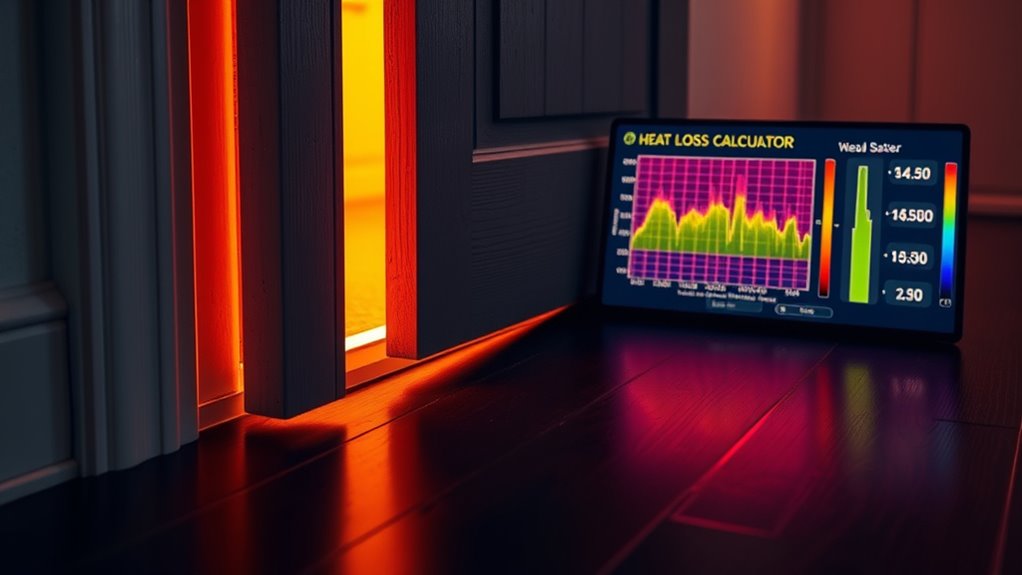
Accurately calculating heat loss requires using specialized tools and techniques that provide reliable data to inform energy efficiency improvements. You can use infrared thermography to identify insulation materials’ weaknesses or employ heat flow meters for precise measurements. Combining these methods with advanced modeling software helps you simulate different scenarios, including ventilation strategies that affect heat retention. Here’s a quick overview:
| Tool/Technique | Purpose | Key Benefit |
|---|---|---|
| Infrared thermography | Detects insulation gaps | Visualizes heat leaks |
| Heat flow meters | Measures heat transfer rates | Quantifies heat loss |
| Computational models | Simulates insulation effects | Tests ventilation impacts |
| Blower door tests | Assesses building airtightness | Improves ventilation strategies |
| Thermal imaging cameras | Identifies thermal bridging | Pinpoints insulation issues |
Additionally, understanding building envelope characteristics can significantly improve heat retention efforts.
Costly Consequences of Ignoring Proper Door Placement

Ignoring proper door placement can lead to higher energy bills, as heat escapes and your HVAC works harder. It also increases the risk of structural damage over time due to uneven temperature fluctuations. Addressing these issues early can save you money and prevent costly repairs down the line.
Increased Energy Bills
Poor door placement can substantially drive up your energy bills, as it allows warm air to escape and cold drafts to enter your home. When your door insulation isn’t ideal, it forces your heating system to work harder, increasing energy consumption. Additionally, poor placement can lead to uncontrolled outdoor airflow, making it harder to maintain a consistent indoor temperature. This results in higher utility costs over time. To minimize these costs, ensure your door is properly sealed and positioned. Consider the following:
- Proper door insulation to reduce heat transfer
- Strategic placement to limit outdoor airflow
- Installing weatherstripping to seal gaps
- Using energy-efficient doors
- Regular maintenance to prevent drafts
Ignoring these factors means your heating bills will keep climbing, wasting energy and money. Proper door placement is a smart investment for long-term savings.
Structural Damage Risks
When doors are improperly placed or poorly installed, they can cause structural issues that lead to costly damage over time. A misaligned door frame may weaken the surrounding structure, causing stress on walls and supporting beams. Poorly fitted doors often create insulation gaps, which allow moisture and drafts to seep in. Over time, these gaps can lead to wood rot, mold growth, and deterioration of the framing materials. Additionally, repeated force from improper closure can warp the door or damage hinges, exacerbating structural instability. Ignoring proper door placement risks not only increased repair expenses but also compromises the safety and integrity of your home. Addressing these issues early ensures your door frame remains sturdy, preventing costly structural damage down the line.
Tips for Preventing Hidden Costs in Future Building Projects

To prevent hidden costs related to door placement and heat loss, thorough planning and proactive assessment are essential. Focus on selecting the right material insulation to boost energy efficiency and reduce long-term expenses. Consider door aesthetics to ensure they complement your building’s design while maintaining functionality. Properly evaluating door positions early on can minimize costly modifications later.
Here are some tips:
- Invest in high-quality insulative materials for doors and surrounding walls
- Prioritize energy-efficient door designs that reduce heat transfer
- Balance door aesthetics with practical placement for ideal performance
- Use heat loss calculators during the planning phase for accurate insights
- Regularly review designs to identify potential hidden costs before construction
Implementing these strategies helps avoid surprises and keeps your project within budget.
Frequently Asked Questions
How Do Door Materials Influence Heat Loss Beyond Placement?
Door materials notably influence heat loss because of their insulation properties and durability. You’ll want to choose materials like solid wood or insulated steel, which offer better insulation and resist wear over time. Less durable options may degrade, creating gaps that increase heat transfer. By selecting high-quality, well-insulated materials, you can reduce heat loss and improve your home’s energy efficiency, saving money on heating costs in the long run.
Can Door Design Features Reduce Heat Transfer Effectively?
You might think door design features can’t do much, but they actually can substantially reduce heat transfer. Proper door insulation and high-quality sealant effectiveness prevent drafts and minimize heat loss. Features like weatherstripping, core material, and threshold design create a tighter seal, making your door more energy-efficient. By investing in these design elements, you can cut heating costs and improve comfort, proving that smart door design truly makes a difference.
What Are the Long-Term Cost Implications of Poor Door Placement?
Poor door placement can lead to costly repairs and ongoing energy wastage. Over time, you might face expensive fixes for drafts, leaks, or damage caused by improper installation. Additionally, your heating and cooling systems work harder to compensate for heat loss, increasing energy bills. To avoid these issues, guarantee proper door placement and insulation, saving you money long-term and maintaining a comfortable, energy-efficient home.
How Does Climate Variability Affect Door Placement Strategies?
When facing unpredictable weather patterns, you should prioritize climate adaptation in your door placement strategies. Shifting your doors to better suit seasonal changes helps minimize heat loss and comfort issues. By thoughtfully considering climate variability, you can create a more resilient home that adapts smoothly to weather fluctuations, reducing long-term energy costs and emotional strain. Embrace flexible placement strategies to guarantee your space remains cozy and efficient year-round.
Are There Industry Standards for Optimal Door Placement in Energy-Efficient Buildings?
Yes, industry guidelines recommend ideal door placement to maximize energy efficiency. You should position doors away from direct sunlight and prevailing wind to reduce heat loss, following standards like those from ASHRAE or local building codes. These guidelines emphasize strategic placement to minimize energy costs, improve insulation, and enhance comfort. By adhering to industry standards, you guarantee your building’s door placement promotes energy conservation and aligns with best practices.
Conclusion
By paying close attention to door placement and using heat loss calculators, you can save a fortune—possibly more than you’d spend on a mansion! Avoid costly mistakes that drain your energy bills and compromise comfort. Take the time to optimize your door positioning now, and you’ll enjoy a cozy, energy-efficient space that feels like a warm hug every day. Don’t let hidden costs turn your dream home into a money pit—plan smart and stay warm!
